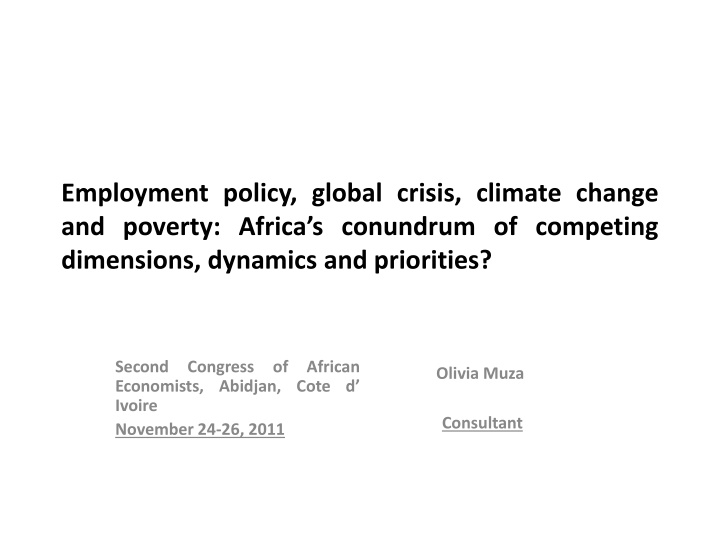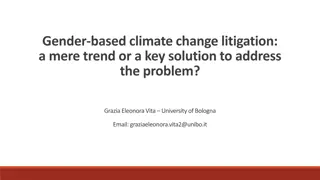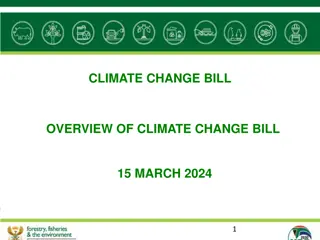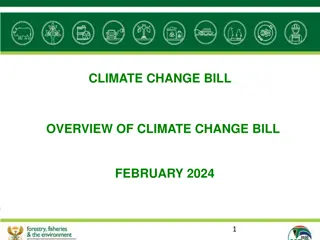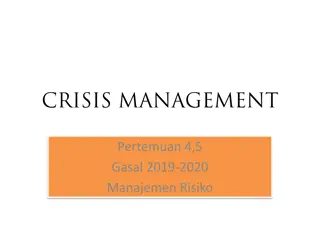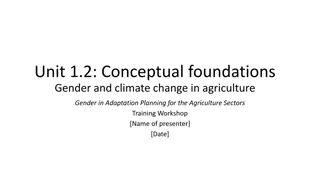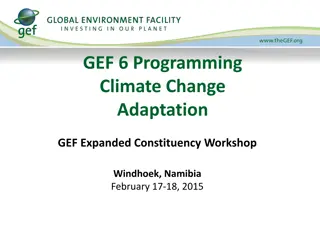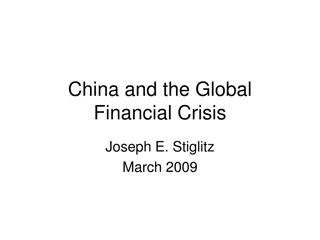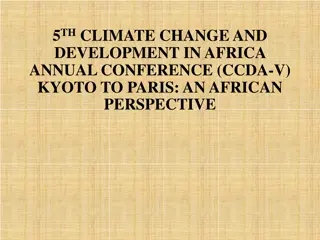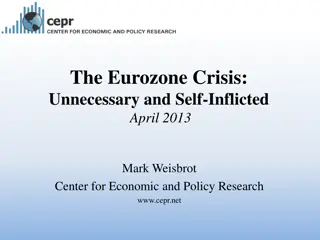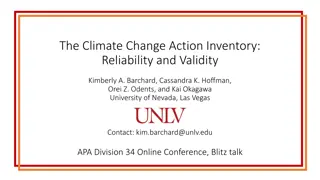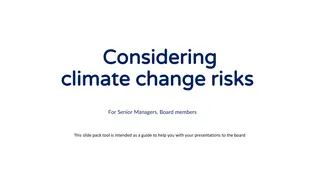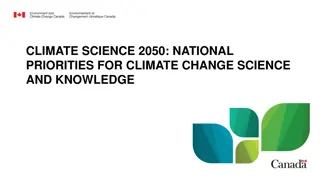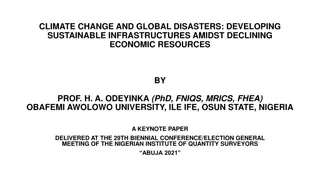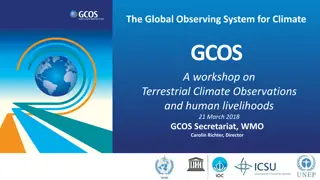Africa's Conundrum: Competing Priorities in the Face of Global Crisis and Climate Change
Africa faces a complex web of challenges including high government expenditure, disease, unemployment, global economic crisis, climate change, and poverty. The global economy is struggling since 2007 with intertwined financial and economic crises. Developing countries are experiencing tough transitions amid slow growth. Unemployment remains a key issue, with millions jobless and living in extreme poverty. Addressing these challenges is crucial for sustainable development and economic recovery in Africa.
Uploaded on Sep 09, 2024 | 3 Views
Download Presentation

Please find below an Image/Link to download the presentation.
The content on the website is provided AS IS for your information and personal use only. It may not be sold, licensed, or shared on other websites without obtaining consent from the author.If you encounter any issues during the download, it is possible that the publisher has removed the file from their server.
You are allowed to download the files provided on this website for personal or commercial use, subject to the condition that they are used lawfully. All files are the property of their respective owners.
The content on the website is provided AS IS for your information and personal use only. It may not be sold, licensed, or shared on other websites without obtaining consent from the author.
E N D
Presentation Transcript
Employment policy, global crisis, climate change and poverty: Africa s conundrum of competing dimensions, dynamics and priorities? Second Economists, Abidjan, Cote d Ivoire November 24-26, 2011 Congress of African Olivia Muza Consultant
Introduction Exactly which unsolved challenges are holding back real growth ? High government and fiscal expenditure Disease/ HIV/AIDS Unemployment Global economic and financial crisis Climate change Poverty Endemic poverty Hunger Higher prevalence of disease Chronic conflicts Low levels of development Low adaptive capacity Solve these first to lift the veil behind which the future lies hidden [David Hilbert, 1900]
Background Since the crisis began in 2007, the global economy unwell Deep and multi-dimensional environmental, food and energy US-financial crisis which turned into an economic crisis Developing countries-economic downturn which turned into a financial crisis Most solutions focused mainly on bank bailouts, slashing interest rates, injecting liquidity Financial interventions alone are not the magic elixir Markets are interconnected, intertwined, interdependent and dependent What are the competing dimensions, dynamics, priorities, choices and options? Is it possible to reconcile the competing paradigms? What are the areas of divergence and convergence respectively? crisis: economic, financial,
Global trends: emerging and frontline issues How is the world doing? Rich countries- disappointingly Developing countries- growing briskly, but face tough transitions of their own A 5.7% growth recorded in Sub-Saharan Africa in 2011 raises a cloud of hope UN report on MDGs shows that progress has been made toward the 2015 achievement, despite the crisis Yet, a slack labour market exist: high unemployment The crisis of our times is the employment crisis Slower growth and job creation implies lower tax revenues, more unemployment and health benefits and a larger deficit Recovery from recession is proceeding
Unemployment and vulnerability in a crisis context Between 210 and 239 million people are without jobs [Global Employment Trends Report] 620 million workers lived with their families in extreme poverty before the crisis Out of employment implies that the workforce lose the talent, skills and work habits Lost generation of workers, lost to their country, their communities and their families Remittances and foreign direct investment Reverse migration Reduced labour mobility International relations
Climate variability and vulnerability in labour markets Dependence and reliance on activities that are vulnerable to climate shocks i.e. agriculture and tourism Undermining the livelihoods of millions in developing countries especially the poorest Climate change threatens to stall or reverse development gains made over the last several decades Climate migrants, conflicts over scarce resources Developed countries emitted most of the gases that are warming the planet- China recently passed the US as the top overall green house gas [GHG] emitters By 2030, International Energy Agency [IEA] speculates that 90% of carbon dioxide emissions will come from the developing world Disappointing enough the late-year 2010 conference in Cancun, did far too little to solve climate change itself Furthermore, no binding treaty on reducing greenhouse emissions and institutional action plan was established
Rising prices and Africas structural problems Reduction in the consumption basket Poor devote half of their spending on food Endemic poverty Hunger Higher prevalence of disease Chronic conflicts Low levels of development Low adaptive capacity
A gendered optical lens in the context of climate change, global crisis and poverty Gender differentiated impact: rural employment-which crops women produce, ability to adapt and respond e.g. Kenya and Zimbabwe, work burden, uncertainty and inability to respond to higher food prices Men in construction industries will also suffer Women eating least and last Female farmers ability to respond to effective coping strategies are limited compared to male farmers Restricted access to productive assets, technology, knowledge and inputs Large farmer responses of increasing informal employment and use of pesticides in response affect paid employment opportunities Negative employment effects on agricultural export industries Increase in female unpaid workload High demand for educated and qualified workers through promoting environmentally sound technologies Linkage between employment, poverty and gender inequality either means Distress sale of labour [Elson, 1999] or Poverty status of the household female-intensive non-traditional
Africas warfare and recommendations for policy epochal development, next generation Recommendation Policy Options 1, Business growth and investments- Clean fuels, energy-efficiency, sustainable forestry, clean economic growth tourism industries, agriculture CLEAN agro- processing, biogas generated by landfills, agriculture residues and other sources of energy, switching out old appliances for energy efficient models, converting to fluorescent light bulbs and promoting alternative sources of income for forest dwellers 2, Green economic growth Low emissions pathway, update or improve greenhouse gas inventories, conduct feasibility studies for renewable energy sources, sharing best practices in wild fisheries management to conserve wetlands 3, Implementing practical adaptation responses Smart investments in adaptation, disaster preparedness and response, the preservation of ecosystem services, encouraging women to engage in paid rural work, access to knowledge and training, agricultural advisory services, credit and land tenure systems, childcare and social services
Africas epochal development, next generation warfare and recommendations for policy Recommendation Policy Options 4, Climate migrants/climate refugees/ immigrants policies Integration businesses, mainly motivated, hardworking and creative people and re-integration, promoting immigrants 5, Informal economy expansion and maintenance Reduction of decent work deficits 6, Promoting SMEs Credit facilities, information and infrastructure 7, Strengthening labour unions- Case study of South Africa: well developed trade unions 8, Opening up exploration, drilling and resource extraction Creating thousands of jobs, significantly increase economic growth and do wonders for the country s BOP, reducing oil imports dramatically i.e. Bakken in North Dakota has already given that state low unemployment rate in the country
Africas warfare and recommendations for policy epochal development, next generation Recommendation Policy Options 9, Enabling tax environments' Low taxes produce high growth and high growth encourage entitlements in the long-run 10, A good work ethic A new generation of workers that work exceptionally well to advance the cause of development 11, Manufacturing German Model of development amid a crisis, focus on technical education, technical apprenticeships, specialise in high-end complex manufacturers products that command a premium price institutes, polytechnic 12, Retraining Retraining programs for the entire generation of workers 13, Rural employment policies NREGA Act in India, implemented in 2005, created a safety net of guaranteed minimum rural households in rural India. Improved food security, health benefits and a chance to avoid hazardous work wage for the poorest
Conclusions Leave out ideology, orthodoxy and embrace creativity, flexibility and pragmatism Transition from slack to tight labour conditions Move away from crisis response to engaging dilemmas , head on strategies Help build a shared regional knowledge base on new priories and sustainability issues
